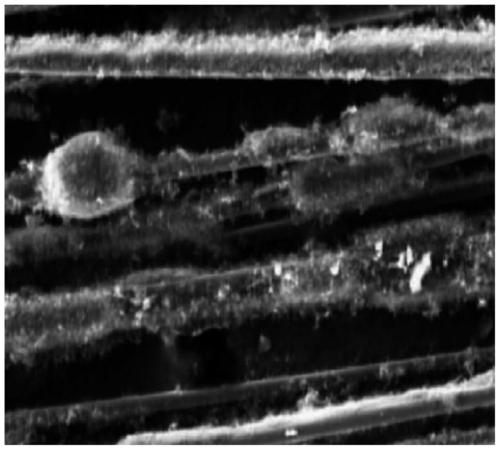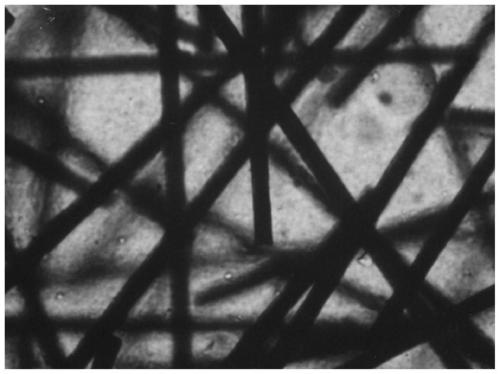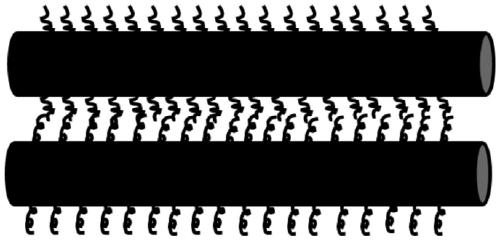Thermoplastic thermistor composite material with positive temperature coefficient and preparation method thereof
A positive temperature coefficient and composite material technology, which is applied to resistors with positive temperature coefficients, resistors, non-adjustable metal resistors, etc., can solve the problems of complex procedures, increased density, high resistivity, etc., and achieve simple manufacturing methods, Enhanced conductivity and less conductive filler
- Summary
- Abstract
- Description
- Claims
- Application Information
AI Technical Summary
Problems solved by technology
Method used
Image
Examples
Embodiment 1
[0048] A positive temperature coefficient thermoplastic thermistor composite material, by weight percentage, comprising the following components:
[0049]
[0050] A positive temperature coefficient thermoplastic thermistor composite material is prepared by the following steps:
[0051] (1) Mix the carbon fiber powder with carbon nanotubes grown on the surface and KH-550 evenly, and dry to obtain a mixture A; the drying temperature is 50° C., and the drying time is 60 minutes;
[0052] (2) The thermoplastic polymer material and the ultra-high molecular weight polyethylene are mechanically mixed with the mixture A at room temperature to obtain the mixture B;
[0053] (3) mix mixture B with antioxidant 1010, UV-P, and naphthenic oil at room temperature and extrude in a twin-screw extruder, cool, dry and granulate to obtain a thermoplastic thermistor composite material; The cooling temperature was 30°C.
Embodiment 2
[0055] A positive temperature coefficient thermoplastic thermistor composite material, by weight percentage, comprising the following components:
[0056]
[0057]
[0058] A positive temperature coefficient thermoplastic thermistor composite material is prepared by the following steps:
[0059] (1) Mix the carbon fiber powder with carbon nanotubes grown on the surface and KH560 evenly, and dry to obtain the mixture A; the drying temperature is 100° C., and the drying time is 10 minutes;
[0060] (2) The thermoplastic polymer material and the ultra-high molecular weight polyethylene are mechanically mixed with the mixture A at room temperature to obtain the mixture B;
[0061] (3) mix mixture B with antioxidant 168, UV-326, and naphthenic oil at room temperature and extrude in a twin-screw extruder, cool, dry and granulate to obtain a thermoplastic thermistor composite material; The cooling temperature was 5°C.
Embodiment 3
[0063] A positive temperature coefficient thermoplastic thermistor composite material, by weight percentage, comprising the following components:
[0064]
[0065] A positive temperature coefficient thermoplastic thermistor composite material is prepared by the following steps:
[0066] (1) Mix carbon fiber powder with carbon nanotubes grown on the surface and KH570 evenly, and dry to obtain mixture A; the drying temperature is 90° C., and the drying time is 50 minutes;
[0067] (2) The thermoplastic polymer material and the ultra-high molecular weight polyethylene are mechanically mixed with the mixture A at room temperature to obtain the mixture B;
[0068] (3) mix mixture B with antioxidant 264, UV-531, and naphthenic oil at room temperature and extrude in a twin-screw extruder, cool, dry and granulate to obtain a thermoplastic thermistor composite material; The cooling temperature was 20°C.
PUM
 Login to View More
Login to View More Abstract
Description
Claims
Application Information
 Login to View More
Login to View More - R&D
- Intellectual Property
- Life Sciences
- Materials
- Tech Scout
- Unparalleled Data Quality
- Higher Quality Content
- 60% Fewer Hallucinations
Browse by: Latest US Patents, China's latest patents, Technical Efficacy Thesaurus, Application Domain, Technology Topic, Popular Technical Reports.
© 2025 PatSnap. All rights reserved.Legal|Privacy policy|Modern Slavery Act Transparency Statement|Sitemap|About US| Contact US: help@patsnap.com



